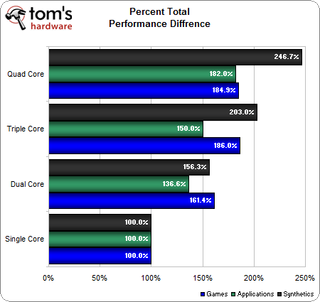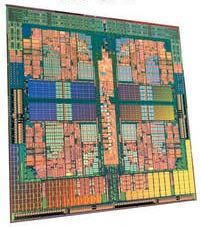How Many CPU Cores Do You Need?
Performance Analysis And Conclusion
Time to draw some conclusions. Because we have a lot of data to digest, let's simplify it by averaging the performance on a graph:

First, we see that the synthetic benchmarks are overly optimistic as to what multiple cores can accomplish compared to the average real-world scenario. The synthetic performance progression between a single core and multiple cores looks like an almost linear progression of 50% performance increases with each new CPU core.
The average application gains show us a much more realistic progression, with about a 35% speed increase with the second CPU core, a 15% jump with the third, and another 32% jump with the fourth. It's strange that the third CPU core seems to provide half the advantage of adding a fourth CPU core to the mix.
And when considering applications, we must look at individual software titles instead of just the big picture. Indeed, the audio-encoding software we tested seems to offer no multi-core optimizations of which to speak. However, video encoding software conversely offers massive benefits with more CPU cores and depends somewhat on the video encoder utilized. In the case of 3D rendering software, 3ds Max usually has highly optimized multi-core performance improvements, while 2D photo editors like Photoshop seem to have none at all. AVG anti-virus demonstrates massive performance increases with multiple cores, while compression utilities seem to sport little to no multi-threading benefits.
As far as games go, we see a huge 60% performance jump from going single-core to dual-core, and a further 25% leap from dual- to triple-core. Quad cores offer no benefits in the sampling of games we tested. While more games might change the landscape a little, we think the triple-core Phenom II X3s are looking good as a low-cost gaming option. It's also important to note here that as you start shifting to higher resolutions and adding visual detail, the picture gets a lot murkier as graphics muscle becomes the prevalent determinant of frame rates.

After all is said and done, we can come to a few general conclusions based on this data. We don't think you have to be a power-user to enjoy the benefits of a multi-core CPU. This is in stark contrast to the situation four years ago. So, while these gains might not be overwhelming at first glance, it's impressive to note how much thread-level optimization has gone on in the last few years, particularly in the applications identified as most receptive to acceleration through parallelism. In fact, we'll go as far as to say that there is relatively little reason to consider a single-core CPU (if you can find one), except for power-saving applications.
There are a few applications for which users should invest in as many CPU cores as possible, which include video encoding, 3D rendering, and optimized productivity titles, such as AVG's virus-scanning software. The lesson for the gamer is that long gone are the days when a single-core CPU paired with a powerful graphics solution would be "good enough."
Stay on the Cutting Edge
Join the experts who read Tom's Hardware for the inside track on enthusiast PC tech news — and have for over 25 years. We'll send breaking news and in-depth reviews of CPUs, GPUs, AI, maker hardware and more straight to your inbox.
-
SpadeM Good piece, this will probably clear up some misunderstandings about dual vs. quad core processors. With just a clarification, that this article is based on the same clock speed (2.7Ghz) for ALL processor cores. And so, in some cases where the software isn't optimized for a multi core experience then going up on the Mhz scale is a valid option. If it wouldn't be, why do we overclock :).Reply -
You have to consider that dual-core processors will often be clocked faster than a quad-core processor at the same price range (Intel Core 2 Duo E8400 @ 3.0GHz vs. Quad Q8200 @ 2.33GHz at $165 on Newegg). Inversely, to get the same clock speed, to get the same clock speed for a quad-core as a dual-core, you will have to pay 2x or more of the dual-core price (E8400 vs. Quad Q9650 - $165 v. $325). You have to ask yourself whether a 30% increase in speed justifies a 100% increase in cost. In certain scenarios, yes, it is worth it. For the average user on a budget, however, dual-core will often be the most cost-effective. Not to mention the over clocking power of mature dual-core processors (but then, an overclocker is not an average user).Reply
-
giovanni86 Great article, i enjoyed seeing some of the gaming conclusions. I guess my CPU having 4 cores is a bit useless even though on some of your graphs it still shows 2 to 3 frames more in some of them compared to having only 3 cores. None the less though great article i enjoyed it very much.Reply -
martindamp What about the average user running multiple programs at the same time. I often run both virus scanner, office applications and multimedia encoding at the same time. With four cores this runs smoothly, but with only one core it would be a pain.Reply -
WheelsOfConfusion Very informative! I keep seeing comments regarding which applications or games are good for multi-core versus single etc, it's good to have some hard data.Reply
And that's a neat trick for creating a standardized platform for the tests, eliminating the architectural differences between single and various multi-core processors.
Since I see a lot of Tom's articles considering power efficiency and read a lot of comments asking for underclock results, it would have been nice to throw some data about power usage with each configuration. Does disabling a core (or three) significantly reduce power consumption? What about temps? -
Proximon I too expected to see some even priced CPU comparison, but this worked out well. Since it's so easy with any quad core system, all we need now is some gamer with a ton of titles to put up a list.Reply
Oh, such things already exist, whaddya know :) -
I second martindamp's question... what happens when you run iTunes, lame, antivirus, and winrar on 1-4 cores?Reply
But what I'm most interested in is what would happen when you move this to a Corei7. It seems to me that some of the apps that see a slowdown while moving to four cores are likely bumping into bandwidth and bus arbitration overheads, as the Q6600 is essentially two C2D's packaged on the same chip, sharing the FSB. The Corei7 eliminates this bottleneck, and I'd be willing to bet the performance decrease from 3->4 cores goes away as well. And when you play around with the i7, you can toy with Turbo and HyperThreading as well, but it'd be most interesting to directly compare the two architectures based on real cores. -
swyn01 Nice article. A few comments for thought though. On the first page it is mentioned how single core CPUs often had a higher clock of newer dual-core CPUs. This fact still exists today between dual-core and quad-core. For example, on newegg, a 2.33 GHz quad-core is about $165. A 3.0 GHz dual-core is $168. That's almost a 29% clock increase for the same amount of money. In the gaming benchmarks, if you multiply the dual-core results by 1.29, you will find that this shows an increased performance over the quad-core benchmark. Just like it did years ago (a faster single core cpu was better for gaming than a slower dual-core), this shows that a faster dual-core is still better for gaming than a slower quad core. At least for now. This will change in the future just as it did for single and dual cores, but I'm sure it will take still a few more years before a higher-clocked dual-core is dethroned to a slower quad-core.Reply -
Summer Leigh Castle Is there a comparison between the i7 and a standard 4-core CPU? I was wondering if the real-world gains are there to justify spending more money for a 4-core hyperthreading CPU?Reply
Most Popular

